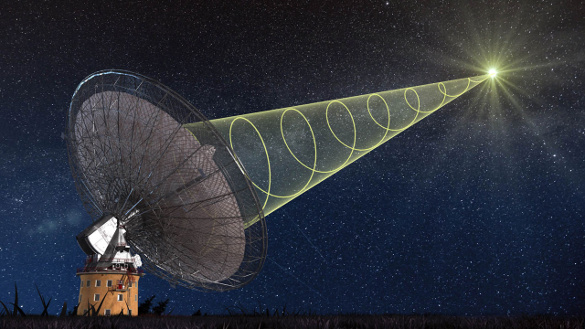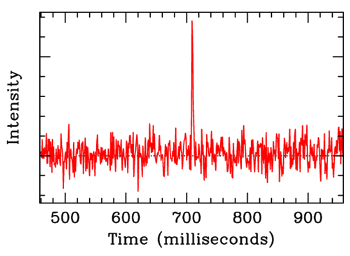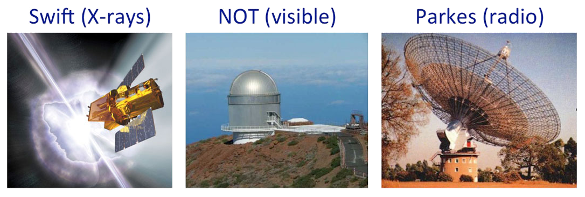Cosmic Radio Burst
March 5, 2015
Unlike other
scientists,
astronomers have the disadvantage that they can't do
experiments. When I do something in my
laboratory, I can be assured of
some observation, although it might not be the result I was expecting. Astronomers, however, work at the whim of the
universe, catching glimpses of
phenomena whenever they're presented. The universe is a big place, and you can't look in all directions at the same time.
Many astronomical discoveries have been made by
accident.[1] Every astronomical discovery made by
Galileo could be called an "accident," but since he was the first to point a
telescope towards the
night sky, I don't think that these really count as accidental. However, I consider the following to be valid accidental discoveries in astronomy.
• Discovery of Uranus. British astronomer, William Herschel (1738-1822), was observing dim stars during March, 1781, and found that one of these was moving. Herschel thought it was a comet, but calculations showed that it was a new planet, later named Uranus.
• Discovery of Ceres. Italian astronomer and catholic priest, Giuseppe Piazzi (1746-1826), discovered the asteroid (now called a dwarf planet), Ceres, on January 1, 1801. Piazzi had been looking for a particular star when he found this moving object that he, too, identified as a comet.
• Universal Expansion. Vesto Slipher (1875-1969) was doing observations of spiral nebulae in 1912, and he found a shift in their spectral lines. These galactic redshifts indicated that the galaxies were rapidly receding from the Earth.
• Extraterrestrial Radio Signals. Karl Jansky, a physicist at Bell Laboratories, was looking for sources of radio interference using a steerable antenna tuned for 20.5 MHz when he discovered the first extraterrestrial radio signals. The signals were coming from the intense radio source, Sagittarius A, located at the center of our galaxy.
• The Big Bang. Arno Penzias and Robert Wilson, also of Bell Labs, were conducting sensitive radio astronomy observations, and they were troubled by a noise signal that spoiled their data. They thought the source of their noise was pigeon droppings in their antenna, but they had actually discovered the cosmic microwave background radiation, a remnant of the Big Bang.
• Gamma-Ray Bursts. In the late 1960s, the United States launched a series of satellites to detect the gamma ray emission from nuclear weapons tests. On July 2, 1967, two of the satellites detected an intense gamma ray burst that wasn't of the type expected for a nuclear weapon. Subsequent satellites with more sensitive detectors detected more bursts, and detailed analysis confirmed that the sources were extraterrestrial. Gamma-ray bursts are the brightest electromagnetic emissions known.
• Supernova SN 2014J. Steve Fossey, an astronomer at the University of London was conducting a telescope workshop with students on January 21, 2014. When they imaged Messier 82, they discovered a type-Ia supernova, now called SN 2014J. This supernova was the closest to Earth since 2004, when SN 2004dj was discovered.
Astronomers at the
Parkes Observatory,
New South Wales,
Australia had the good fortune on May, 14, 2014, to have detected a type of radio emission called a
fast radio burst. Their observation allowed follow-up observation of this burst, designated FRB 140514, at other
wavelengths within hours of that event. The origin of such radio bursts is unknown; and, before this event, follow-up observations at other wavelengths had not been done.[2-5]

Artist's representation of the Parkes radio telescope detecting fast radio burst FRB 140514. This telescope was completed in 1961 as one of the first with a fully-steerable antenna. Parkes has a place in history as a receiving station for the video of the first humans on the Moon during the Apollo 11 expedition. (Via Niels Bohr Institute.)
This
research was done by a huge international team of members from the
Swinburne University of Technology (Hawthorn, Australia), the
CSIRO Australia Telescope National Facility (Epping, Australia), the
Australian Research Council Centre of Excellence for All-sky Astrophysics, the
Harvard-Smithsonian Center for Astrophysics (Cambridge, Massachusetts),
Curtin University (Bentley, Australia), the
Australian National University (Canberra, Australian), the
California Institute of Technology (Pasadena, California),
Max Planck Institut für Radioastronomie (Bonn, Germany), the
Tata Institute of Fundamental Research (Pune, India), the
Max Planck Institut für extraterrestrische Physik (Garching, Germany), the
NASA Goddard Space Flight Center (Greenbelt, Maryland), the
Carnegie Institution for Science (Pasadena, California), the
Jet Propulsion Laboratory (Pasadena, California), the
University of Manchester (Manchester, United Kingdom), the
Niels Bohr Institute (Copehagen, Denmark), the
Weizmann Institute of Science (Rehovot, Israel),
INAF -
Osservatorio Astronomico di Cagliari (Selargius, Italy), the
Kavli Institute for Astronomy and Astrophysics, Peking University (Beijing, China),
Sorbonne Universités (Paris, France), and the
Institut d'Astrophysique de Paris (Paris, France).
Just seven such bursts have been found, most from
archival data, six at Parkes, and one at the
Arecibo Observatory in
Puerto Rico.[4] As the detection curve below shows, the pulse was extremely short, much less than ten
milliseconds. Noting the background noise, it might be that even this short pulse width might have been limited by
instrumental affects, so it could have been shorter still. Since the
speed of light sets a limitation on the size of the source of such a fast pulse, the responsible object can't be larger than a few hundred
kilometers.

Signal obtained from the fast radio burster, FRB 140514
(Swinburne Astronomy Productions image, via Niels Bohr Institute.)
It was suspected that the sources for these pulses are at
cosmological distances; in which case, the sources must be very
energetic, such as the merger of
neutron stars or
black holes. It was also suspected that there might be a connection with
gamma ray bursts, another energetic cosmic phenomenon. The data from the FRB 140514 allowed the team to winnow the list of potential sources.
The Parkes instrumentation allowed
polarimetry to be performed for the first time on a fast radio burst. FRB 140514 was found to be 21±7%
circularly polarized on the leading edge, which suggests a nearby
magnetic field.[2-4] A
dispersion measurement gave an upper limit on source
redshift of z ≲ 0.5.[2-3] Thus, the source is likely 5.5 billion
light years from Earth.[4-5] Follow-up observations by 12 telescopes, observing from
X-ray to radio wavelengths, disallowed the possibility that the source was a nearby
supernova or a long-duration gamma-ray burst.[2-3]

A wide swath of the electromagnetic spectrum was observed in the study of the fast radio burst, FRB 140514. There were X-rays from the Swift satellite, optical light from the Nordic Optical Telescope, and radio waves from the Parkes telescope. (Via Niels Bohr Institute.)
What's interesting about this study is that no trace of the burst was found at wavelengths other than radio.[4] Says
Daniele Malesani, a participant from the Niels Bohr Institute,
“We found out what it wasn't. The burst could have hurled out as much energy in a few milliseconds as the Sun does in an entire day. But the fact that we did not see light in other wavelengths eliminates a number of astronomical phenomena that are associated with violent events such as gamma-ray bursts from exploding stars and supernovae, which were otherwise candidates for the burst."[4]
At this point, fast radio bursts might still be associated with
magnetic neutron stars called
magnetars, black holes, stellar collisions, "
starquakes," or short gamma ray bursts.[4-5]
References:
- Andrea Thompson, "Accidental Astronomy: Expect the Unexpected," Space.com, January 1, 2010.
- E. Petroff, M. Bailes, E. D. Barr, B. R. Barsdell, N. D. R. Bhat, F. Bian, S. Burke-Spolaor, M. Caleb, D. Champion, P. Chandra, G. Da Costa, C. Delvaux, C. Flynn, N. Gehrels, J. Greiner, A. Jameson, S. Johnston, M. M. Kasliwal, E. F. Keane, S. Keller, J. Kocz, M. Kramer, G. Leloudas, D. Malesani, J. S. Mulchaey, C. Ng, E. O. Ofek, D. A. Perley, A. Possenti, B. P. Schmidt, Yue Shen, B. Stappers, P. Tisserand, W. van Straten, and C. Wolf, "A real-time fast radio burst: polarization detection and multiwavelength follow-up," Monthly Notices of the Royal Astronomical Society, vol. 447, no. 1 (February 11, 2015), pp. 246-255 .
- E. Petroff, M. Bailes, E. D. Barr, B. R. Barsdell, N. D. R. Bhat, F. Bian, S. Burke-Spolaor, M. Caleb, D. Champion, P. Chandra, G. Da Costa, C. Delvaux, C. Flynn, N. Gehrels, J. Greiner, A. Jameson, S. Johnston, M. M. Kasliwal, E. F. Keane, S. Keller, J. Kocz, M. Kramer, G. Leloudas, D. Malesani, J. S. Mulchaey, C. Ng, E. O. Ofek, D. A. Perley, A. Possenti, B. P. Schmidt, Yue Shen, B. Stappers, P. Tisserand, W. van Straten, and C. Wolf, "A real-time fast radio burst: polarization detection and multiwavelength follow-up," arXiv, December 1, 2014.
- Snapshot of cosmic burst of radio waves, Niels Bohr Institute Press Release, January 19, 2015.
- Caught in the act: Cosmic radio burst, Carnegie Institution Press Release, January 20, 2015.
Permanent Link to this article
Linked Keywords: Scientist; astronomer; experiment; laboratory; universe; phenomenon; phenomena; serendipity; accident; Galileo Galilei; telescope; night sky; British; William Herschel (1738-1822); star; comet; calculation; planet; Uranus; catholic priest; Giuseppe Piazzi (1746-1826); asteroid; dwarf planet; Ceres; Vesto Slipher (1875-1969); spiral galaxy; spiral nebula; spectral line; galaxy; galactic; redshift; metric expansion of space; Earth; Karl Guthe Jansky; physicist; Bell Labs; Bell Laboratories; electromagnetic interference; radio interference; antenna; MHz; outer space; extraterrestrial; radio frequency; signal; Sagittarius A; Arno Penzias; Robert Woodrow Wilson; radio astronomy; noise; data; pigeon; feces; droppings; cosmic microwave background radiation; Big Bang; 1960s; United States; Vela satellite; gamma ray emission; >nuclear weapons test; sensor; detector; Gamma-ray burst; electromagnetic emission; Steve Fossey; University of London; workshop; student; Messier 82; type-Ia supernova; SN 2014J; Parkes Observatory; New South Wales; Australia; fast radio burst; wavelength; Artist; history; receiving station; video; human; Moon; Apollo 11; Niels Bohr Institute; research; Swinburne University of Technology (Hawthorn, Australia); CSIRO Australia Telescope National Facility (Epping, Australia); Australian Research Council; Centre of Excellence for All-sky Astrophysics; Harvard-Smithsonian Center for Astrophysics (Cambridge, Massachusetts); Curtin University (Bentley, Australia); Australian National University (Canberra, Australian); California Institute of Technology (Pasadena, California); Max Planck Institut für Radioastronomie (Bonn, Germany); Tata Institute of Fundamental Research (Pune, India); Max Planck Institut für extraterrestrische Physik (Garching, Germany); NASA Goddard Space Flight Center (Greenbelt, Maryland); Carnegie Institution for Science (Pasadena, California); Jet Propulsion Laboratory (Pasadena, California); University of Manchester (Manchester, United Kingdom); Niels Bohr Institute (Copehagen, Denmark); Weizmann Institute of Science (Rehovot, Israel); INAF; Osservatorio Astronomico di Cagliari (Selargius, Italy); Kavli Institute for Astronomy and Astrophysics, Peking University (Beijing, China); Sorbonne Universités (Paris, France); Institut d'Astrophysique de Paris (Paris, France); archival data; Arecibo Observatory; Puerto Rico; millisecond; impulse response; instrumental affects; speed of light; kilometer; cosmological distance; energetic; neutron star; black hole; gamma ray burst; polarimetry; circular polarization; circularly polarized; magnetic field; dispersion; redshift; light year; X-ray; supernova; electromagnetic spectrum; Swift Gamma-Ray Burst Mission; Swift satellite; Nordic Optical Telescope; Daniele Malesani; Sun; magnetic; magnetar; starquake.